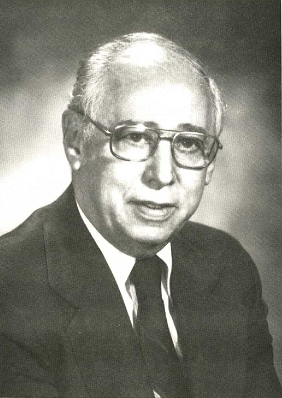
“Rabbi James A. Wax.” Rabbi James A. Wax Collection, DIG Memphis.
James Aaron Wax, distinguished rabbi and man of letters, was born December 20, 1912 in St. Louis, Missouri. In 1914, his parents, Morris and Rose Edlin Wax, moved to the small southeastern Missouri town of Herculaneum. His childhood there would play an important part in shaping the civic consciousness that so marked his career.
From his childhood, he recalls his father instilling two tenets in him: “You’ve got to be a good Jew, and by that he meant to live up to the moral principles, to be an honorable person. And you’ve got to be a good citizen.” This idea of good citizenship led him to “[hope] to reform the world; be for the little guy.” These beliefs stayed with him throughout his life.
A graduate of the local high school, James Wax entered Washington University at St. Louis in 1930 and later transferred to Southeast Missouri State College, where he received a Bachelor of Arts degree in 1935. Wax was encouraged to enter the rabbinate by a Christian clergyman who recognized his gifts. He was further persuaded while listening to a rabbi speak: “The rabbi was talking about social justice and human dignity. And I thought, ‘Gee, if that’s what the Jewish religion is really about, I wouldn’t mind getting involved.” He entered Hebrew Union College in Cincinnati, where he was awarded the Bachelor of Hebrew Letters in 1939 and the Master of Hebrew Letters in 1941.
Following ordination, Rabbi Wax served congregations at Glencoe, Illinois and St. Louis, Missouri. While serving the congregation in Glencoe, he married Helen Louise Goldstrom on February 5, 1945. Two sons, Jonathan Ira and James Aaron, Jr., were born to this union. Called to be Associate Rabbi of Temple Israel, Dr. and Mrs. Wax moved to Memphis in 1946. He served as Co-Rabbi with Dr. Harry Ettelson until 1954, when Dr. Wax became Senior Rabbi, the position he held until his retirement in 1978, at which time he was named Rabbi Emeritus.
One of his earliest memories of Memphis was an interaction he had one summer day with a black man outside the Peabody Hotel Drug Store. The man asked, “Do you think I can go in there and get a glass of water?” Wax replied he did not think it was possible. He recalled, “It was very upsetting to me. Here was a human being who was thirsty and couldn’t get a glass of water. It exemplified the situation [in Memphis].” Because of experiences like this and because he believed religion should be related to life and connected with the issues of the world, Wax stated he “spoke on everything, including integration.” Wax’s long-time assistant, Rabbi Danziger, remembered “When he began preaching racial justice, it was before one became a folk hero for doing it. You couldn’t give Rabbi Wax anything not to speak out. He did what a rabbi is supposed to do.”
The belief of what was right led Wax to join the initial attempt to study the problem of race relations in Memphis. However, Wax felt that while it was a noble beginning, it was doomed to failure as the organizers had created two separate committees: one white and one black. Wax recalls, “I couldn’t see it. Here were two groups going through the motions of trying to maintain harmony without solving even the first problem.” The second attempt resulted in the formation of the Memphis Committee on Community Relations in 1957, and it is credited with helping integrate Memphis’ public facilities in the early 1960s. Wax recalls integration being successful in Memphis, but it lacked genuine acceptance: “There was mostly a spirit of good will. And it was tough for white owners. One of the motivating factors for business people was not the moral question, but ‘we’ve got to protect the image of Memphis.’ That phrase ‘image’ was used a number of times. I used to sit back and think, ‘That’s not much of a motivation.’”
His beliefs originating from childhood, his recognition of Memphians’ lack of integration acceptance, and his brushes with discrimination resulting from anti-Semitism may have made him particularly empathetic to racial discrimination issues in Memphis. He believed “It’s not a big deal if you can’t join a country club, or a social club. I don’t put any stock in that. But discrimination is important if it prevents you from sharing in the political process, if you can’t vote or if the government enacts discriminatory laws. And if you can’t share in the economic life of the community, if you’re barred from a profession or business.”
In addition to his personal feelings of the overall situation in Memphis, his desire to avoid community turmoil forced his direct involvement in strike negotiations during the 1968 Sanitation Strike. Wax, the Memphis Ministers Association president, organized and led meetings between the city and union to support ongoing communication in an attempt to ease racial tensions in the city. He maintained a neutral position until the assassination of Martin Luther King, Jr. when he joined in the pro-striker march to city hall and told Mayor Henry Loeb, “there are laws greater than the laws of Memphis and Tennessee and these are the laws of God. We fervently ask you not to hide any longer behind legal technicalities and slogans but to speak out at last in favor of human dignity.”
Before and following his involvement in the strike, Wax was well-known for his active role in civic and community leadership. Rabbi Wax brought his love of humanity and reasoned approach to countless organizations. Among those groups that have benefited from his dedicated service to the community have been the Tennessee Department of Mental Health, the Memphis Ministers’ Association, the National Conference of Christians and Jews, and the Urban League. Despite his many accomplishments, Wax felt helping others was his crowning achievement: “If I did anything to be remembered for, I hope it’s … because I believed in the brotherhood of man.”
Beifuss, Joan. “Remembering Rabbi James Wax.” Memphis Magazine, February 1981.
Biographical Sketch of Rabbi James A. Wax, May 1988. Box 6, Folder 12. Rabbi James A. Wax Collection. History Department, Memphis Public Libraries, Memphis, TN.
Letter to Rabbi Richard G. Hirsch from Rabbi James A. Wax, May 29, 1968. Box 5, Folder 6. Rabbi James A. Wax Collection. History Department, Memphis Public Libraries, Memphis, TN.






